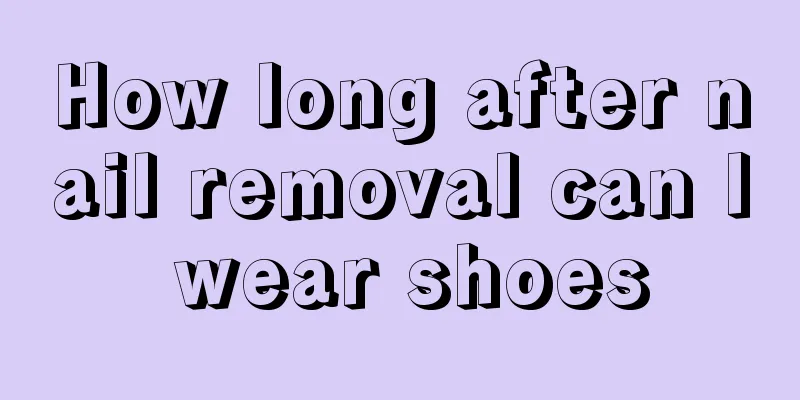How long after nail removal can I wear shoes

|
Onycholysis is a treatment method for severely diseased fingernails or toenails. The old nail is pulled out and the new nail is allowed to grow out, eliminating the previous problems. After nail removal, certain preparations need to be done to allow the wound to recover better and avoid infection. Generally, you cannot wear shoes immediately after the operation. You need to wait five to seven days until there is no obvious infection before you can wear shoes! 1. How long after nail removal can I wear shoes? Generally speaking, if there is no infection within five to seven days, you can wear loose shoes, but don't exercise too much, pay attention to local hygiene, and avoid local irritation. It may take half a month to fully heal. Active anti-infection treatment is required after surgery, and cephalosporins, erythromycin, fosfomycin, etc. can be used. 2. Methods of removing nails 1. Main equipment. Routinely disinfect and cut the package. 2. Perform routine disinfection and nerve trunk block anesthesia, and tie the base of the fingers (toes) with rubber strips or gauze to prevent excessive bleeding and maintain the anesthesia effect. 3.Surgical operation. The operator pinches both sides of the distal phalanx of the affected finger with the thumb and index finger of the left hand to control bleeding. Make a longitudinal incision on both sides of the nail root, separate the nail epithelium along the nail root with a sharp knife, and then separate the nail from the nail bed from the tip of the nail along the nail bed surface. When the nail is completely free, use hemostatic forceps to clamp one side of the nail and roll it to the other side to separate the nail from the nail bed. After checking that there is no residue on the nail corner, cover it with vaseline gauze and then bandage it with sterile gauze. 4. Postoperative treatment (1) Change the dressing. Change the dressing of infected wounds daily until the wound heals. Change the dressing of sterile wound every 5 to 7 days. (2) Patients with suspected periungual bacterial infection should take antibiotics for 5 to 7 days after surgery. 3. Notes 1. When using a sharp-edged knife to separate the nail epithelium, be careful not to damage it to avoid deformities of the nail growing out of the nail epithelium in the future. When separating the nail bed, you should keep it close to the nail, with the blade pointing toward the back of the nail, and be careful not to damage the nail bed tissue. After removing the nail, if the nail bed is uneven, it is advisable to gently scrape it flat with a knife to avoid uneven growth of new nails in the future. 2. To prevent damage to the nail bed, you can also use a knife to separate the nail bed at the tip of the nail, and then insert a mosquito hemostatic forceps into the gap. When separating the hemostatic forceps, the nail can be separated from the nail bed. 3. When removing nails due to onychomycosis, it is difficult to turn over and remove the nails because the nails are brittle. |
<<: What are the uses of laser
>>: How long can the whitening injection last?
Recommend
What are the precautions for taking intestinal moisturizing capsules
Some people have very bad gastrointestinal tract ...
Preparation before bronchoscopy
Bronchoscopy is a common examination. When the pa...
How to clean oil stains on clothes
In daily life, when we are eating, oil may drip o...
What are the causes of laryngeal cancer?
Laryngeal cancer (carcinoma oflarynx) accounts fo...
Selection of authoritative hospital for kidney cancer
Kidney cancer is a type of cancer caused by the c...
What should you pay attention to when using tea to remove foot odor
There are many ways to remove foot odor in life, ...
Why does taking anti-inflammatory drugs cause bladder pain
Anti-inflammatory drugs are a very common medicin...
What are the uses of dilute sulfuric acid and sodium chloride?
Chemical substances are essential basic raw mater...
What is the pathology of rectal cancer
In recent years, rectal cancer has become one of ...
Is cyst serious?
Cyst is a relatively unfamiliar thing for many pe...
Anxiety and fast heartbeat
Many people experience anxiety and a rapid heartb...
Causes of colon cancer
A high-fat diet is a major cause of colon cancer....
What is diphtheria, an acute respiratory infectious disease
Diphtheria is an acute respiratory infectious dis...
What is carbohydrate antigen 12-5? What factors lead to carbohydrate antigen 12-5
Overview Keywords: Carbohydrate antigen 12-5 Engl...
The ten major disadvantages of hot yoga
Yoga is actually a very good exercise. Nowadays, ...









